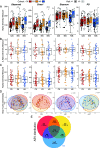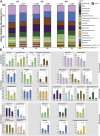Electronic Cigarette Use Promotes a Unique Periodontal Microbiome
- PMID: 35189698
- PMCID: PMC8903898
- DOI: 10.1128/mbio.00075-22
Electronic Cigarette Use Promotes a Unique Periodontal Microbiome
Abstract
Electronic cigarettes (e-cigs) have become prevalent as an alternative to conventional cigarette smoking, particularly in youth. E-cig aerosols contain unique chemicals which alter the oral microbiome and promote dysbiosis in ways we are just beginning to investigate. We conducted a 6-month longitudinal study involving 84 subjects who were either e-cig users, conventional smokers, or nonsmokers. Periodontal condition, cytokine levels, and subgingival microbial community composition were assessed, with periodontal, clinical, and cytokine measures reflecting cohort habit and positively correlating with pathogenic taxa (e.g., Treponema, Saccharibacteria, and Porphyromonas). α-Diversity increased similarly across cohorts longitudinally, yet each cohort maintained a unique microbiome. The e-cig microbiome shared many characteristics with the microbiome of conventional smokers and some with nonsmokers, yet it maintained a unique subgingival microbial community enriched in Fusobacterium and Bacteroidales (G-2). Our data suggest that e-cig use promotes a unique periodontal microbiome, existing as a stable heterogeneous state between those of conventional smokers and nonsmokers and presenting unique oral health challenges. IMPORTANCE Electronic cigarette (e-cig) use is gaining in popularity and is often perceived as a healthier alternative to conventional smoking. Yet there is little evidence of the effects of long-term use of e-cigs on oral health. Conventional cigarette smoking is a prominent risk factor for the development of periodontitis, an oral disease affecting nearly half of adults over 30 years of age in the United States. Periodontitis is initiated through a disturbance in the microbial biofilm communities inhabiting the unique space between teeth and gingival tissues. This disturbance instigates host inflammatory and immune responses and, if left untreated, leads to tooth and bone loss and systemic diseases. We found that the e-cig user's periodontal microbiome is unique, eliciting unique host responses. Yet some similarities to the microbiomes of both conventional smokers and nonsmokers exist, with strikingly more in common with that of cigarette smokers, suggesting that there is a unique periodontal risk associated with e-cig use.
Keywords: dysbiosis; electronic cigarette; microbiome; periodontitis; subgingival plaque.
Conflict of interest statement
The authors declare no conflict of interest.
Figures







References
Publication types
MeSH terms
Substances
Grants and funding
LinkOut - more resources
Full Text Sources
Medical

